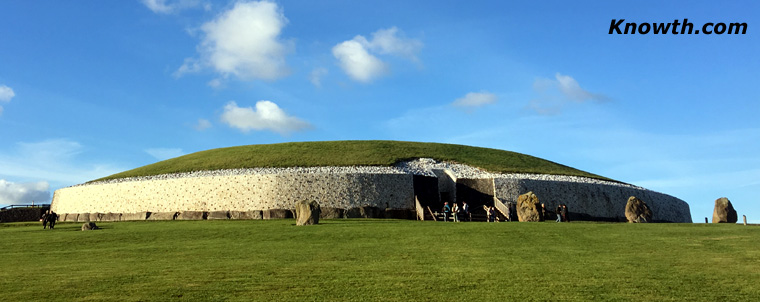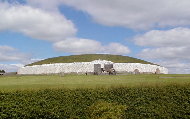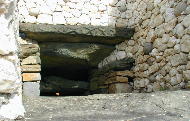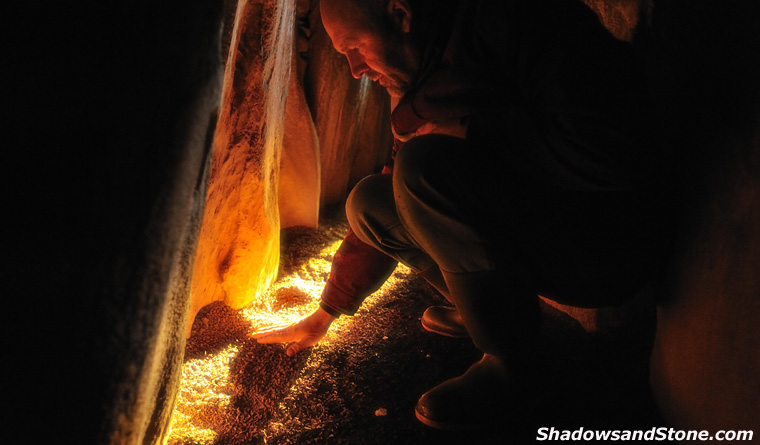New Grange - A Passage to the Afterworld

New Grange was built during the New Stone Age by the farming community of the Boyne Valley
New Grange is arguably one of the finest monuments of European pre-history. Dating to circa 3200 B.C., it was built during the Neolithic or New Stone Age by a wealthy farming community that prospered on the rich lands of the Boyne Valley.
Archaeologists classify New Grange as a passage tomb, but for its builders, New Grange was much more than simply a place of burial. It housed the spirits of their ancestors, providing a link for the living community to the world of their deities and serving as a focal point for ritual and celebration.
Passage tombs, as the name implies, consist of a passage leading to a chamber where the remains of the dead (usually cremated) were placed. The passage and chamber are covered by a large mound of stones and earth, retained at the base by large kerbstones. The amount of time and labor invested in their construction tells us much about the well-organized societies and specialized groups responsible for different aspects of their construction.
New Grange is part of a large complex of monuments built along a bend of the River Boyne known collectively as Brú na Bóinne. The other two principal monuments are Knowth (the largest) and Dowth, but throughout the region there are as many as 35 smaller passage-tombs and many other sites of great archaeological importance and interest.
Excavations conducted beginning in 1962 revealed Knowth to be a complicated multi-period site. There are 18 smaller tombs around the great mound, at least two of which are even older than it is. Knowth was a focal point for ritual activity until the early Bronze Age. After that there is a gap in the story until about the time of Christ, when the mound was transformed into a fortified dwelling. Settlement continued at Knowth, and by 800 A.D. it was the residence of the Kings of Northern Brega, one of whom became High King of Ireland. Though these settlements are significant, it is as a passage tomb cemetery that its fame and intrigue lie.
Dowth is the least well-known of the three great tombs of the Boyne Valley. It has not yet been excavated, but initial investigations reveal two passage tombs within the mound.
Of the three main passage tombs in the Boyne Valley, New Grange has always attracted the most attention. For, although it may not be unique in Western Europe, its mound contained a secret that remained hidden for hundreds of years.
The New Grange Passage
The passageway within New Grange is just less than 60 feet long and leads into a chamber with three side recesses. This chamber is roofed by a corbelled vault, which has remained intact and watertight without any conservation or repair. The cairn (stone mound) that covers the chamber is estimated to weigh 200,000 tons and is retained at its base by 97 massive kerbstones.As is typical of Irish passage tombs, the recess on the right as one enters is the largest and most ornate. On the floor of this recess lie two stone basins, one inside the other. The outer basin is a superb example of the skill of its Neolithic makers, having been shaped from solid granite, as opposed to the other two recesses, which were carved from sandstone. Archaeologists believe that these stone basins once held the remains of the dead.
Because the chamber was disturbed before proper excavation, it is not known how many people were originally interred at New Grange. The remains of five bodies were recovered inside, though the original number was probably much higher. Most of the bones found had been cremated, with only small amounts left unburned. The artefacts remaining in the grave at the time of its excavation were beads made of bone as well as pendants and polished stone balls. Undoubtedly, these objects held a special significance in the burial ritual. It is possible that more spectacular objects were originally present but were removed without having been recorded.
Chronology
The chamber at New Grange has been accessible in modern times since 1699. Before then it appeared merely as a large, overgrown mound much as Dowth appears today. Curiously, even though it was recognized as a man-made feature, it lay undisturbed for centuries, most likely due to superstition and out of respect for the dead.In Celtic mythology, New Grange (or Si An Bhru as it was once known) was the home of the greatest of the Celtic gods, the Dagda Mor and his son Aongus. And throughout most of history, New Grange was revered as a sacred place.
A New Age, with New Pottery
Around 2000 B.C., new people and/or new ideas reached Ireland. This era is called the Beaker period and is characterized by a distinctive type of pottery. Although stone tools continued to be used at this time, they were gradually replaced during the rise of metalworking. When the Beaker people were living beside it, New Grange, as a monument, had fallen into disuse. Its entrance was completely blocked by the collapsing cairn. That is not to say, however, that New Grange played no part in the daily lives of the Beaker people. The monument continued to be a focal point for ritual gathering. Within 30 feet of the passage-tomb, they constructed a massive circular enclosure now called a woodhenge or pit circle. Excavations have shown it to be a large double circle of wooden posts (about 300 feet in diameter) inside which animals were cremated and buried in pits. It seems that the woodhenge served as a religious centre as important in its day as the huge passage tomb had been.Stone Circle
A circle of 12 menhirs (upright boulders) surrounds New Grange. Originally, there may have been more, but if so, they were dislodged long ago. Following the excavation of the woodhenge, it became apparent that the stone circle was erected sometime after 2000 B.C. The purpose of the stone circle is unclear, but research indicates that it could have had an astronomical function. In any case, it was the final stage of building at New Grange.With the coming of the Celts, New Grange was transformed into a house for their deities. Brú na Bóinne is featured in many of the great Celtic myths. As a dwelling place of the deities, it was revered even by visitors from Roman Britain as late as 400 A.D. Their votive offerings of coins and jewelry were recovered from the top of the mound during excavations.
After the establishment of the Cistercians at Mellifont Abbey in 1142, the land around the monument was acquired by the Order. It became a new grange (outlying farm) of the abbey, thus giving the passage tomb and the surrounding townland its modern name.
After 1699, when the chamber was opened, New Grange became a place of interest to antiquarians. It was not until 1962, however, that the first major excavation of the site began. After the excavation, the interior passage was straightened and enclosed by a second passage (now unseen) in order to relieve the pressure from the weight of the mound. The original facade of sparkling white quartz was rebuilt using stone found at the site. The height and angle of the facade match the original and were calculated by measurements taken from the collapsed retaining wall.
Going in Circles
 The artwork of passage-tomb builders has excited interest since the
monuments were first discovered. The motifs of passage-tomb art are
spirals, lozenges, chevrons, triangles, and arrangements of parallel
lines or arcs.
The artwork of passage-tomb builders has excited interest since the
monuments were first discovered. The motifs of passage-tomb art are
spirals, lozenges, chevrons, triangles, and arrangements of parallel
lines or arcs.
At New Grange, many of the stones display a dramatic sense of composition, the designs deeply carved and relating closely to the natural shape of the rocks. The entrance stone is generally regarded as one of the finest achievements of European Neolithic art.
Knowth has an even greater collection of art, with inscriptions on more than 300 of the stones. At New Grange and Knowth, the art on many of the stones continues beyond the visible area. During the excavations it was found that many stones were carved on their undersides and on the sides that are turned inwards toward the cairns. Whatever the art meant to the builders of these enigmatic monuments, perhaps it was not necessarily intended to be seen by the living. It is also possible that the builders re-used stones that had been part of earlier monuments.
Many attempts have been made to interpret passage tomb art. There are some who say that the art looks like a series of maps of the area, maps of the stars, or maps of the afterworld. Some see the art as a meditation device or argue that it represents images induced by hallucinogens. Others argue that it is music. The most popular theory is that the forms represent the changing seasons, the passage tomb builders' preoccupation with time and with marking major solar events like the solstices and the equinoxes. Perhaps the changing and cyclical nature of the seasons were bound in the people's minds with their own lives. Perhaps from their observations of the natural world they hoped that just as winter was followed by spring, new life followed death.
Winter Solstice
 Above the entrance to the passage at New Grange there is a
window-like opening called a roof-box. This baffling orifice held a
great surprise for those who unearthed it. Its purpose is to allow
sunlight to penetrate the chamber on the shortest days of the year,
around December 21, the winter solstice.
Above the entrance to the passage at New Grange there is a
window-like opening called a roof-box. This baffling orifice held a
great surprise for those who unearthed it. Its purpose is to allow
sunlight to penetrate the chamber on the shortest days of the year,
around December 21, the winter solstice.
At dawn, from December 19th to 23rd, a narrow beam of light penetrates the roof-box and reaches the floor of the chamber, gradually extending to the rear of the passage. As the sun rises higher, the beam widens within the chamber so that the whole room becomes dramatically illuminated. This event lasts for 17 minutes, from roughly 8:58 a.m. until 9:15 a.m.
New Grange's accuracy as a time-telling device is remarkable when one considers that it was built 500 years before the Great Pyramids and more than 1,000 years before Stonehenge. The intent of its builders was undoubtedly to mark the beginning of the new year. In addition, it may have served as a powerful symbol of the victory of life over death.
Each year the winter solstice event attracts much attention at New Grange. Many gather at the ancient tomb to wait for dawn, as people did 5,000 years ago. So great is the demand to be one of the few inside the chamber during the solstice that there is a free annual lottery (application forms are available at the Visitor Centre). Unfortunately, as with many Irish events that depend upon sunshine, if the skies are overcast, there is not much to be seen. Yet all agree that it is an extraordinary feeling to wait in the darkness, as people did so long ago, for the longest night of the year to end.
New Grange is open to the public year-round. Knowth is open from May to October. Visitors must begin at the Brú na Bóinne Visitor Centre, on the opposite side of the River Boyne, where they will be transported to the sites by bus. The number of people who can visit each day is limited, and visitors during high season should be prepared for long delays. Access is not always guaranteed.
Acknowledgement: content based on an article by Clare Tuffy first published in The World Of Hibernia magazine.
Boyne Valley Private Day Tour
 Immerse yourself in the rich heritage and culture of the Boyne Valley with our full-day private tours.
Visit Newgrange World Heritage site, explore the Hill of Slane, where Saint Patrick famously lit the Paschal fire.
Discover the Hill of Tara, the ancient seat of power for the High Kings of Ireland.
Book Now
Immerse yourself in the rich heritage and culture of the Boyne Valley with our full-day private tours.
Visit Newgrange World Heritage site, explore the Hill of Slane, where Saint Patrick famously lit the Paschal fire.
Discover the Hill of Tara, the ancient seat of power for the High Kings of Ireland.
Book Now
Home
| Newgrange
| Knowth
| Dowth
| Hill of Tara
| Fourknocks
| Loughcrew
| More Places
| Labyrinths
| Local Info
| Art Works
| Articles
| Images
| Books
| Links
| Boyne Valley Tours
| Contact

